历史百科 严复与变法维新
Posted 光绪
篇首语:宁愿跑起来被拌倒无数次 也不要规规矩矩走一辈子。本文由小常识网(cha138.com)小编为大家整理,主要介绍了历史百科 严复与变法维新相关的知识,希望对你有一定的参考价值。
历史百科 严复与变法维新
清光绪二十年(1894),中日甲午战争的失败及《马关条约》的签订,给中国人民以极大的震动,朝野上下一致发出要求维新变法的呼声。一批最先接受西方资产阶级思想的知识分子,面对清廷的腐败昏庸,深感亡国灭种的严重威胁,于是提出用和平的手段,自上而下进行改革,通过君主立宪的道路,把中国变成资本主义强国。
光绪二十一年(1985),以维新派的代表人物康有为为首的1300余名在京应试的举人,联名 “公车上书” (因举人进京会试乘公车,史称 “公车上书” ),宣告了中国维新变法运动的开始。
天津作为北京的门户,南北水陆交通枢纽,自然受到很大影响,成为北方维新运动的重要阵地。其代表人物,就是当时担任天津水师学堂总教习的严复。
严复与北京 “公车上书” 相呼应,从光绪二十一年(1895)正月初十起到四月,在天津?直报》发表了《论世变之亟》、《原强》、?辟韩》、《救亡决论》等文章,全面提出了救亡图存,变法维新的主张。特别是在《辟韩》中,用资产阶级的民主观,否定了封建主义的“君臣之论” ,成为维新派批判封建主义的最有力的武器。
光绪二十三年十月一日 (1897年10月26日),严复与友人王修植、夏曾佑等人,又在天津创办了 《国闻报》 (日报),为天津维新变法思想的传播,为陆续颁行的变法新政,进行了充分报道,为资产阶级的政治改良运动大造舆论。它不仅是天津由中国人创办的最早报纸,而且是维新派在华北地区出版的唯一报纸,同时也是维新派创办的第一家日报。
《国闻报》创办后一个月,又编辑出版了《国闻汇编》,作为旬刊,严复译述的 《天演论》和?群学肄言》的部分译文,即在旬刊上首次发表。由于这些报刊及时报道了各地维新变法活动和先进的思想观点,阅后使人耳目一新,影响很大,与当时梁启超在上海主办的《时务报》交相辉映,被视为宣传维新变法思想的南北两大阵地。
光绪二十四年 (1898),从正月初六到十四日,严复在《国闻报》上发表《拟上皇帝书》,此后并受到光绪皇帝召见,遵命将此书修缮抄呈,由军机处转上,后因政变,未能上达。

·严复1905年于伦敦留影
特别是,光绪二十四年(1898)闰三月二日,严复译述的英国赫胥黎的《天演论》,在天津出版。他并翻译了亚当斯密的《原富》、斯宾塞尔的《群学肄言》等西方资产阶级名著,第??次系统地介绍了西方资产阶级古典经济学、政治与法学理论及社会学、逻辑学,传播了西方资产阶级的文化。严复在论文中还时常加入自己的按语,联系中国的实际,表达中国应该变法维新,以救亡图存的思想。
在变法维新思潮的影响下,天津掀起了办报纸、设学会、建学堂的热潮,到光绪二十四年(1898),天津发行的进步报刊就有20余种。
最引人注目的是建学堂。主要学堂有: 天津育才馆、俄文馆、矿务学堂、芦汉铁路学堂、严氏家塾等。而且在学校体制、教学内容和考试制度等方面,也都进行了改革。天津各书院一律改试策论。天津原有6所大小书院,有的归并到北洋高等学堂,有的改为天津府中学堂、天津县小学堂,问津书院和辅仁书院也改成了学堂,同时还设立了编译书局; 还派学生赴日留学,学习新技术。
在军事方面也进行了一些改革。袁世凯接管的 “定武军”在天津小站使用新式武器,按西方国家军队的模式进行操练。
戊戌变法失败后的第7天,《国闻报》冲破禁网,在《视死如归》的标题下,报道了谭嗣同等六君子被害的消息。对维新志士的死难及他们勇于牺牲的精神,表示了哀悼和敬意。戊戌变法失败后,天津也重新恢复了旧制,《国闻报》等被查禁停办,严复被监视,各学会被迫停止活动。资产阶级企图通过变法维新,振兴中华的梦想彻底破灭。
此后不久,《国闻报》报馆卖给了日本人。清光绪二十七年(1901),改版为《天津日日新闻》,虽然汉奸方若为主编,但却完全控制在日本人手里。成为日本文化侵略的工具。
In 1894(the 12th year of Emperor Guangxu),China\'ssetbacks in the Sino-Japanese War of 1894-1895 and thesigning of Treaty of Shimonoseki shocked the nationand aroused the appeal for reform.Intellectuals who hadaccepted the Western Bourgeois thoughts criticized thecorruption of the Qing Government and worried aboutthe future of the nation. They wished to turn China intoa capitalist power through the reform from top to bottomin peaceful ways.
In 1895,Kang Youwei,a representative of thereformists,led 1,300 or so Juren,successful candidatesin the imperial examinations at the provincial level inQing Dynasty,submitted a petition to the royal court,embarking of the Constitutional Reform Movement inChina.
Tianjin,as the gate to Beijing and the traffic hingeof sea and land,was the hub of the ConstitutionalReform Movement in northern China. The leader of themovement in Tianjin was Yan Fu,the dean of TianjinNavy School.
To echo the reform movement in Beijing,Yan Fupublished a series articles,such as Lun Shibian Zhiji(On Society),Yuanqiang (The Original Power),Pihan,Jiuwang Juelun (Final Theory on Saving the Nation fromDistinction) from January to April in 1895. Yan\'s articleselaborated his thoughts on how to save China throughthe Constitutional Reform Movement. Especially inPihan,Yan denied the feudal relationship betweenemperor and his ministers from the perspective ofBourgeis democracy,which became the most powerfulweapon of the reformists in criticizing the feudalism.
On October 26,1897,Yan Fu,Wang Xiuzhi andXia Zengyou created Guowenbao (National News Daily)to promote the ideas of Constitutional Reform. Thenewspaper was the first newspaper created by th Chinesepeople in Tianjin as well as the only one compiled byrefomists in northern China. Onemonth after the establishmentof the newspaper,Yan alsocompiled Guowen Huibian (theCollection of National News),which was issued once every10 days. The latter publicationcarried parts of the Chinesetranslation of Evolution and Ethics written by ThomasHenry Huxley as well as parts of Social Statistic byHerbert Spencer. All the newspapers reported in timethe ideas,thoughts and activities of ConstitutionalReform Movement,producing profound influencesamong readers. The National News Daily,together withLiang Qichao\'s Shiwubao (Current Affairs Newspaper)in Shanghai,were regarded as the two pillar media topromote the Constitutional Reform Movement.
From January 6 to 14,1898,Yan published the NiShang Huangdi Shu (A Letter to the Emperor) and wasreceived by Emperor Guangxu. The letter was asked tobe copied and forwarded by the Ministry of Defense,butit did not reach the emperor due to an aborted coup.
In 1898,Yan\'s translation of Huxley\'s Evolutionand Ethics was published in Tianjin. He also translatedseveral other western classics such as Wealth of Nationsby Adam Smith and Social Statistic by Herbert Spencer.For the first time,Yan introduced systematically theWestern Bourgeois classic economics,political theories,legal theories,sociology and logic to China. In histranslations,Yan added his own comments concerningChina\'s practice to promote his thoughts that only theConstitutional Reform could save China.
Influenced by the constitutional movement,there was an upsurge of editing newspapers,foundingassociations and building schools in Tianjin. By 1898,there were more than 20 newspapers advocatingadvanced ideas in Tianjin.
A most remarkable influenceof the Reform Movement wasto build schools,which mainlyincluded Tianjin Talent TrainingSchool,Russian School,MiningSchool,Luhan Railway School,Yan\'s Family School and so on. Theeducation system,curriculum andexaminations in the schools were also reformed. Allthese schools adopted examinations of politics writing.As to Tianjin\'s original six schools,some were affiliatedto Beiyang Higher School,and some others were mergedinto Tianjin Middle School or Tianjin County PrimarySchool. The Wenjin Shuyuan and Furen Shuyuan werealso changed into schools. A publishing house wasfounded to compile and translate books. Some studentswere sent to Japan to study new technologies.
In military aspect,Yuan Shikai took over 4,000Dingwu soldiers stationed in Xiaozhan and trained themin western methods with the equipment of advancedweapons.
On the 7th day after the failure of the ConstitutionalReform Movement,the Guowenbao carried an articleentitled Shisi Rugui (To Face Death Unflinchingly),which reported for the first time the death of TanSitong and other five reformists. It praised highly of thespirits of the reformists and expressed condolence tothe dead. After that,Tianjin\'s old system was retrievedand the newspaper Guowenbao was shut down. TheBourgeois tried in vain to strengthen China through theConstitutional Reform Movement.
Soon after that,the newspaper was sold to theJapanese. In 1901,the newspaper was renamed asTianjin Riri Xinbao (Tianjin Daily News),to which FangRuo served as the editor-in-chief. It turned out that Fangwas a traitor and the newspaper was fully controlled bythe Japanese for their invasion towards China.

相关参考
因受中日甲午战争以后民族危机严重的刺激,清朝开始出现以康有为、严复、梁启超、谭嗣同等为主要代表的维新派。他们为了救国开展了一系列的运动措施。下面小编就给大家说一说维新派创办《时务报》。1896年8月9
翻译赫胥黎《天演论》的严复是一位很有个性的人,他不同于清高自负、恃才傲骨的旧式文人,他信奉“此天演之所以进化”,但又不因此一味地贵新鄙旧,无论对传统还是对新知,提出自己独有的看法与主张,显得非常的
《天演论》的三次改订,可能的确提升了翻译质量,力争达到严复本人所倡导的“信达雅”的因素在里边。但这三次改订的文本细节,又能够让人明确感受到,译著者本人的微妙心态与心理变化,并非一如标签化的“天演学家”
严复的简介,介绍,传记,故事 名人姓名:严复 出生年代:1854~1921 名人国家:中国 严复介绍: 姓名:严复 性别:男 出生年月:1854~1921 籍贯: 民族:汉 严
人物档案 姓名:严复 初名:传初 改名:宗光 字:又陵、几道 国家:中国 民族:汉族 所处时间:中国近代 出生地:福建侯官 出生时间:公元1854年 去世时间:公元1921年
历史人物 清末教育家严复简介,《天演论》作者严复的思想主张是什么
生平经历1854年1月8日(咸丰三年十二月十日)严复出生于今福建候官县盖山镇阳岐村一中医世家。1866年(同治五年)严复父亲病逝,学馆中辍,严复放弃走科举“正途”。1867年(同治六年)入福州船政学堂
严复是中国近代精通“西学”的第一流人物。在中国人民向西方寻求真理的历史过程中,他第一个大量地、系统地把西方资产阶级的新文化、新思想介绍到中国来。他一生翻译了二百多万字的西方社会学说和自然科学名著。他翻
人物档案 姓名:严复 初名:传初 改名:宗光 字:又陵、几道 国家:中国 民族:汉族 所处时间:中国近代 出生地:福建侯官 出生时间:公元1854年 去世时间:公元1921年
严复是中国近代史上的著名人物,著名的翻译家和教育家、新法家代表人物、资产阶级启蒙思想家,被誉为是近代中国开启民智的一代宗师。他首倡“信、达、雅”的译文标准对后世翻译工作有着巨大影响,康有为、梁启超、毛
严复和老北京的“姻缘” – 暨纪念严复诞辰165周年 (名人北京足迹系列之一)
165年前的今日,严复出生于福建省福州府侯官县。165年后的今日,让我们来追忆一下这个在中国近代史上留下了辉煌足迹的一代宗师,以及他在北京留下的足迹。>提及沙滩老北大,更多的人会想到蔡元培、陈独秀、胡